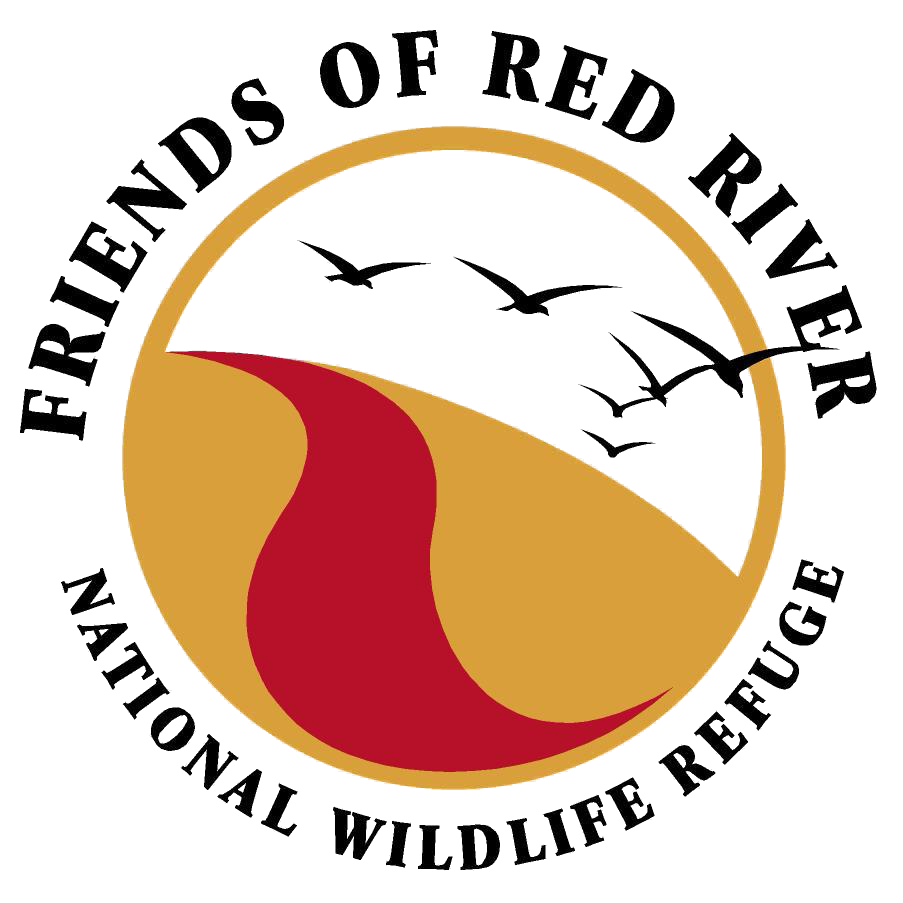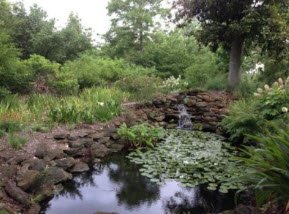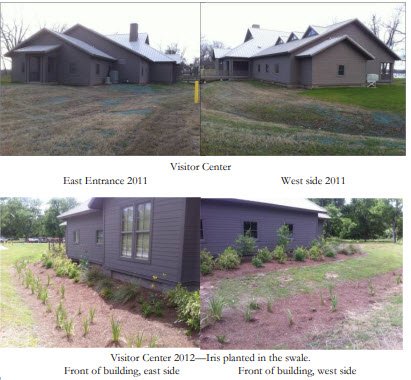Habitat Restoration Project
Pond at Wild Garden
Note: This is a reprint from the Louisiana Native Plant Society, August 2021 newsletter. Only a portion of the article is provided here. Access full article.
This is a story about a pecan orchard that is slowly being converted to native habitat and two of the volunteers that are working to make that happen. Janet Creech and her sidekick, me Gloria McClure, work on the restoration project at the Red River National Wildlife Refuge (RRNWR) Headquarters Unit. Very little of the original habitat (bottomland hardwoods, cypress, and shrub swamps) exists at the site. The Headquarters Unit of the refuge is located in an urban setting at 150 Eagle Bend Point in Bossier City, LA. It is a significant asset for Bossier Parish and the surrounding metropolitan area serving a population of approximately 436,000. The Headquarters Unit is a diverse campus providing the community with a visitor and education center, boat dock on Lake Caroline, fishing, wildlife observation and photography, and walking trails. The condensed history of the RRNWR is below. These are not my words, and I saw no reason to recreate the wheel, but I do think it is important for one to understand in what way the refuge came about. The history also brings awareness to a significant fact: we are volunteering on Federal lands. With this fact comes many rewards and opportunities, but it also comes with a large portion of rules, comprehensive conservation plans, restrictions, guidelines, levees, flooding, and protected hungry deer. The Refuge System is managed by the Fish and Wildlife Service (Service), an agency within the U.S. Department of the Interior. The Service is the primary Federal entity responsible for conserving and enhancing the Nation’s fish and wildlife populations and their habitats. Although the Service shares this responsibility with other Federal, State, tribal, local, and private entities, the Service has specific trust resource responsibilities for migratory birds, threatened and endangered species, certain anadromous fish, certain marine mammals, coral reef ecosystems, wetlands, and other special aquatic habitats. The Service also has similar trust responsibilities for the lands and waters it administers to support the conservation and enhancement of all fish and wildlife and their associated habitats. The mission of the National Wildlife Refuge System is to administer a national network of lands and waters for the conservation, management and, where appropriate, restoration of the fish, wildlife and plant resources and their habitats within the United States for the benefit of present and future generations of Americans. Red River National Wildlife Refuge is made up of four units in the Red River Valley in northwestern Louisiana. Headquarters Unit in Bossier and Caddo Parishes, Bayou Pierre Unit in Desoto and Red River Parishes, Lower Cane Unit in Natchitoches Parish and Spanish Lake Lowlands in Natchitoches Parish. The first property was acquired on August 22, 2002. The Visitor Center, Headquarters Offices and Education Center opened in January 2012. The refuge is important to waterfowl, wading birds and songbirds especially. The Red River National Wildlife Refuge (NWR) was created legislatively by the Red River National Wildlife Refuge Act - signed into law on October 13, 2000. The first land purchase was made in August 2002 consisting of 1,377 acres. According to legislation, the refuge shall consist of approximately 50,000 acres of Federal lands and waters along that section of the Red River between Colfax, Louisiana and the Arkansas state line, a distance of approximately 120 miles. Therefore, Red River NWR is comprised of a headquarters unit and four additional focus units. Red River NWR is located in the Red River Valley which historically was forested with bottomland hardwoods, cypress sloughs and shrub/scrub swamps, providing a variety of habitats for wildlife. In the early 1800’s, settlers began clearing land for homesteads and farms after the Louisiana Purchase. The mid-1800’s brought more clearing for cotton farming and during the mid-1900’s, deforestation accelerated with the increase in soybean prices.
Changes at the Visitor Center
In 1870, Captain Shreve began clearing log jams to make the Red River more navigable and attempts to improve navigation continued with the completion of the lock and dam system in 1994. Completion of the Red River Waterway Project in 1994 led to higher and more consistent water levels in the river which has greatly reduced the turbidity. Water quality has improved and with the seasonal retention of water levels, a rich diversity of aquatic plants has developed. Increased water levels on the river also improved conditions for some wildlife. Flooded timber and farm fields with wet, depressional areas are now more common and are being used by wading birds, waterfowl, and other animals. USDA programs such as the Wetlands Reserve Program (WRP) and Conservation Reserve Program (CRP) are restoring valuable wildlife habitat through the reforestation of marginal farmlands and highly erodible lands in the Red River Valley. Once the 50,000 acres have been acquired, the refuge will connect with other conservation areas reducing habitat fragmentation and providing wildlife corridors and stop-over areas for migrating waterfowl and songbirds. Red River NWR is a relatively new Refuge; therefore, public use areas and opportunities are being added as staff and funding grow. For more information go to www.fws.gov/northlouisiana/RedRiver/ Though the Headquarters Unit officially opened in January of 2012, it was in 2011 that Pat Stinson, manager of the Unit, contacted Janet Creech. Pat had learned of her skills creating native habitats at the Louisiana State Exhibit Museum and at Shreve Island Elementary School. He needed a project leader to develop the 4 acres of grounds surrounding the Unit’s visitor center, so he asked for her help. Janet accepted the challenge and began by documenting the site. As you can see from the images above, it was a blank slate. Access full article.
WELCOME TO FRIENDS OF THE RED RIVER NATIONAL WILDLIFE REFUGE
We welcome your ideas for monthly news. Please contact us.



